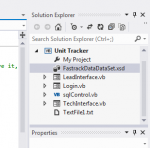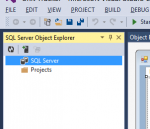jwcoleman87
Well-known member
- Joined
- Oct 4, 2014
- Messages
- 124
- Programming Experience
- Beginner
I've learned how to talk to an sql database without Linq, or so I think. Well, let me show you what I've learned how to do without Linq
This code is bulky, and ugly, and not very reuseable. Every time I want to do something different with my tables I need to write new functions, or overridden copies of old functions. I'm hoping that linq can solve my issue. The problem is, I'm not quite sure where to start. Does anyone have a resource with a basic Linq tutorial. I went to the MSDN and the first thing it had me do was Imports System.Data.Linq, and it turns out that System.Data.Linq is not found. (I thought I was already using linq in a previous example from another thread, which is also on this front page. I already have a dataset added to my project, which includes all the tables I want to work with. It is redundant for me to continue and use this old class (while adding even more mess to it) alongside that already existing data object.
Where to begin?
Public Class sqlControl
Public sqlCon As New SqlConnection
Public sqlCmd As SqlCommand
Public sqlDA As SqlDataAdapter
Public sqlDataset As DataSet
Public Function Login(User As String, Pwd As String) As Boolean
Try
'us04w025
sqlCon.ConnectionString = "Server = us04w025;Database = FastrackData; User = 'Technician'; pwd = 'Asurion1';Persist Security Info=True"
If hasConnection() = True Then
runQuery("SELECT UserID, UserPWD FROM Technician " & _
"WHERE UserID = '" & User & "' " & _
"AND UserPWD = '" & Pwd & "'")
If sqlDataset.Tables(0).Rows.Count > 0 Then
Return 1
Else
MsgBox("User name or password is incorrect")
Return 0
End If
End If
Catch ex As Exception
MsgBox(ex.Message())
Return False
End Try
Return False
End Function
Public Function hasConnection() As Boolean
Try
sqlCon.Open()
sqlCon.Close()
Return True
Catch ex As Exception
MsgBox(ex.Message)
Return False
End Try
End Function
Public Function runQuery(Query As String) As DataSet
Try
sqlCon.Open()
sqlCmd = New SqlCommand(Query, sqlCon)
'LOAD SQL RECORDS FOR DATAGRID
sqlDA = New SqlDataAdapter(sqlCmd)
sqlDataset = New DataSet
sqlDA.Fill(sqlDataset)
sqlCon.Close()
Return sqlDataset
Catch ex As Exception
MsgBox(ex.Message)
End Try
Return sqlDataset
End Function
Public Function BeginRepair(serialNumber As String, startTime As DateTime,
status As String) As Integer
Dim UpdateCmd As String = (" UPDATE Repair " & _
"SET Status ='" & status & "', " & _
"StartTime = '" & startTime & "'" & _
"WHERE SerialNumber = '" & serialNumber & "'")
Try
sqlCon.Open()
sqlCmd = New SqlCommand(UpdateCmd, sqlCon)
Dim ChangeCount As Integer = sqlCmd.ExecuteNonQuery()
sqlCon.Close()
Return ChangeCount
Catch ex As Exception
MsgBox(ex.Message)
End Try
Return 0
End Function
Public Function AssignRepair(serialNumber As String, techID As String, status As String) As Integer
Try
Dim strInsert As String = "INSERT INTO Repair " & _
"(SerialNumber, TechnicianID, Status)" & _
"VALUES (" & _
"'" & serialNumber & "'" & _
",'" & techID & "'" & _
",'" & status & "')"
sqlCon.Open()
sqlCmd = New SqlCommand(strInsert, sqlCon)
sqlCmd.ExecuteNonQuery() ' for insert, update, or delete
Catch ex As Exception
MsgBox(ex.Message)
Return 0
End Try
sqlCon.Close()
Return 1
End Function
Public Function ChangeAssignment(SerialNumber As String, UserName As String,
Status As String) As Integer
Dim UpdateCmd As String = (" UPDATE Repair " & _
"SET TechnicianID ='" & UserName & "', " & _
"Status = '" & Status & "', " & _
"StartTime = NULL ," & _
"EndTime = NULL " & _
"WHERE SerialNumber = '" & SerialNumber & "'")
Try
sqlCon.Open()
sqlCmd = New SqlCommand(UpdateCmd, sqlCon)
Dim ChangeCount As Integer = sqlCmd.ExecuteNonQuery()
sqlCon.Close()
Return ChangeCount
Catch ex As Exception
MsgBox(ex.Message)
End Try
Return 0
End Function
Public Function UpdateRepair(NewSerialNumber As String, OldSerialNumber As String) As Integer
Dim UpdateCmd As String = (" UPDATE Repair " & _
"SET SerialNumber ='" & NewSerialNumber & "' " & _
"WHERE SerialNumber = '" & OldSerialNumber & "'")
Try
sqlCon.Open()
sqlCmd = New SqlCommand(UpdateCmd, sqlCon)
Dim ChangeCount As Integer = sqlCmd.ExecuteNonQuery()
sqlCon.Close()
Return ChangeCount
Catch ex As Exception
MsgBox(ex.Message)
End Try
Return 0
End Function
Public Function ChangeDisposition(SerialNumber As String, NewStatus As String) As Integer
Dim UpdateCmd As String = (" UPDATE Repair " & _
"SET Status ='" & NewStatus & "' " & _
"WHERE SerialNumber = '" & SerialNumber & "'")
Try
sqlCon.Open()
sqlCmd = New SqlCommand(UpdateCmd, sqlCon)
Dim ChangeCount As Integer = sqlCmd.ExecuteNonQuery()
sqlCon.Close()
Return ChangeCount
Catch ex As Exception
MsgBox(ex.Message)
End Try
Return 0
End Function
Public Function UpdateRepair(SerialNumber As String, EndTime As DateTime,
Status As String, CSRQuoteFlag As Integer) As Integer
Dim UpdateCmd As String = (" UPDATE Repair " & _
"SET Status ='" & Status & "', " & _
"EndTime = '" & EndTime & "'," & _
"CSRQuoteFlag = '" & CSRQuoteFlag & "' " & _
"WHERE SerialNumber = '" & SerialNumber & "'")
Try
sqlCon.Open()
sqlCmd = New SqlCommand(UpdateCmd, sqlCon)
Dim ChangeCount As Integer = sqlCmd.ExecuteNonQuery()
sqlCon.Close()
Return ChangeCount
Catch ex As Exception
MsgBox(ex.Message)
End Try
Return 0
End Function
Public Function UpdateRepair(SerialNumber As String, TechnicianId As String, StartTime As DateTime,
Status As String) As Integer
Dim UpdateCmd As String = ("UPDATE Repair " & _
"SET TechnicianID ='" & TechnicianId & "', " & _
"StartTime = '" & StartTime & "'," & _
"Status = '" & Status & "' " & _
"WHERE SerialNumber='" & SerialNumber & "'")
Try
sqlCon.Open()
sqlCmd = New SqlCommand(UpdateCmd, sqlCon)
Dim ChangeCount As Integer = sqlCmd.ExecuteNonQuery()
sqlCon.Close()
Return ChangeCount
Catch ex As Exception
MsgBox(ex.Message)
End Try
Return 0
End Function
Public Function SendToUnitRepair(SerialNumber As String, TechnicianId As String,
Status As String, StartTime As DateTime) As Integer
Dim UpdateCmd As String = ("UPDATE Repair " & _
"SET TechnicianID ='" & TechnicianId & "', " & _
"StartTime = '" & StartTime & "'," & _
"EndTime = NULL, " & _
"Status = '" & Status & "' " & _
"WHERE SerialNumber='" & SerialNumber & "'")
Try
sqlCon.Open()
sqlCmd = New SqlCommand(UpdateCmd, sqlCon)
Dim ChangeCount As Integer = sqlCmd.ExecuteNonQuery()
sqlCon.Close()
Return ChangeCount
Catch ex As Exception
MsgBox(ex.Message)
End Try
Return 0
End Function
Public Function ListActiveRepairs(ByVal List As ListBox, TechnicianID As String) As ListBox
List.Items.Clear()
sqlCmd = New SqlCommand("SELECT SerialNumber FROM REPAIR " & _
"WHERE TechnicianID = '" & TechnicianID & "'" & _
"AND Status = 'Unit Repair'", sqlCon)
sqlCon.Open()
Dim R As SqlDataReader = sqlCmd.ExecuteReader()
While R.Read
List.Items.Add(R.GetString(0))
End While
sqlCon.Close()
Return List
End Function
Public Function ListAssignedRepairs(ByVal List As ListBox, TechnicianID As String) As ListBox
List.Items.Clear()
sqlCmd = New SqlCommand("SELECT SerialNumber FROM REPAIR " & _
"WHERE TechnicianID = '" & TechnicianID & "'" & _
"AND Status = 'Assigned'", sqlCon)
sqlCon.Open()
Dim R As SqlDataReader = sqlCmd.ExecuteReader()
While R.Read
List.Items.Add(R.GetString(0))
End While
sqlCon.Close()
Return List
End Function
Public Function ListInactiveRepairs(ByVal List As ListBox, TechnicianID As String, SelectedDate As Date) As ListBox
List.Items.Clear()
Try
sqlCmd = New SqlCommand("SELECT SerialNumber FROM REPAIR " & _
"WHERE TechnicianID = '" & TechnicianID & "'" & _
"AND Status <> 'Unit Repair' " & _
"AND CONVERT(date, EndTime, 101) = '" & SelectedDate & "'" & _
"AND Status <> 'Paused'" & _
"AND Status <> 'Assigned'", sqlCon)
sqlCon.Open()
Dim R As SqlDataReader = sqlCmd.ExecuteReader()
While R.Read
List.Items.Add(R.GetString(0))
End While
sqlCon.Close()
Return List
Catch ex As Exception
MsgBox(ex.Message)
End Try
End Function
Public Function GetRepairRecords(SerialNumber As String) As DataSet
Dim RepairRecord As New DataSet
RepairRecord = runQuery("SELECT * From Repair WHERE SerialNumber = '" & SerialNumber & "'")
Return RepairRecord
End Function
Public Function GetRepairRecords(TechnicianID As String, Status As String, DateBegan As String, DateFinished As String,
HourBegan As String, HourFinished As String, CSRQuoteFlag As String) As DataSet
Dim RepairRecords As New DataSet
RepairRecords = runQuery("SELECT * FROM Repair " & _
"WHERE TechnicianID = '" & TechnicianID & "' " & _
"AND Status = '" & Status & "' " & _
"AND Convert(date, StartTime, 101) = '" & DateBegan & "'" & _
"AND Convert(date, EndTime, 101) = '" & DateFinished & "'" & _
"AND DATEPART(hour, StartTime) = = '" & HourBegan & "'" & _
"AND DATEPART(hour, EndTime) = '" & HourFinished & "'" & _
"AND CSRQuoteFlag = '" & CSRQuoteFlag & "' ")
End Function
Public Function TotalRepairs(TechnicianID As String, SelectedDate As DateTime, Status As String) As Integer
runQuery("SELECT COUNT(ALL SerialNumber) From Repair " & _
"WHERE CONVERT(date, EndTime, 101) = '" & SelectedDate.Date & "'" & _
"AND Status = '" & Status & "' " & _
"AND TechnicianID = '" & TechnicianID & "'")
Return sqlDataset.Tables(0).Rows(0).Item(0)
End Function
End Class
This code is bulky, and ugly, and not very reuseable. Every time I want to do something different with my tables I need to write new functions, or overridden copies of old functions. I'm hoping that linq can solve my issue. The problem is, I'm not quite sure where to start. Does anyone have a resource with a basic Linq tutorial. I went to the MSDN and the first thing it had me do was Imports System.Data.Linq, and it turns out that System.Data.Linq is not found. (I thought I was already using linq in a previous example from another thread, which is also on this front page. I already have a dataset added to my project, which includes all the tables I want to work with. It is redundant for me to continue and use this old class (while adding even more mess to it) alongside that already existing data object.
Where to begin?
Last edited:




